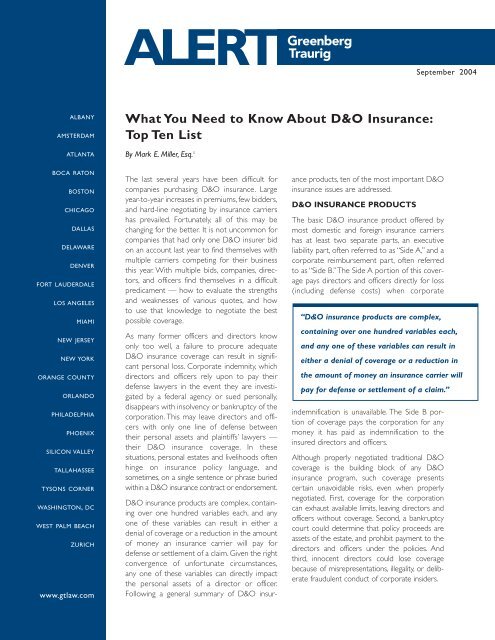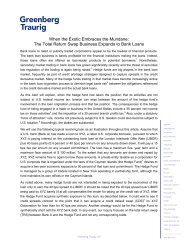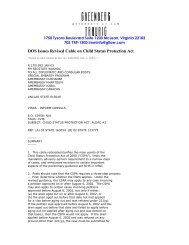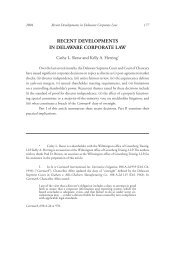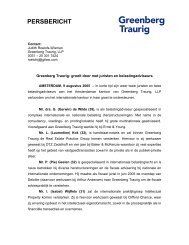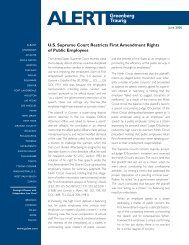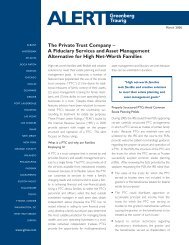What You Need to Know About D&O Insurance - Greenberg Traurig ...
What You Need to Know About D&O Insurance - Greenberg Traurig ...
What You Need to Know About D&O Insurance - Greenberg Traurig ...
Create successful ePaper yourself
Turn your PDF publications into a flip-book with our unique Google optimized e-Paper software.
ALBANY<br />
AMSTERDAM<br />
ATLANTA<br />
BOCA RATON<br />
BOSTON<br />
CHICAGO<br />
DALLAS<br />
DELAWARE<br />
DENVER<br />
FORT LAUDERDALE<br />
LOS ANGELES<br />
MIAMI<br />
NEW JERSEY<br />
NEW YORK<br />
ORANGE COUNTY<br />
ORLANDO<br />
PHILADELPHIA<br />
PHOENIX<br />
SILICON VALLEY<br />
TALLAHASSEE<br />
TYSONS CORNER<br />
WASHINGTON, DC<br />
WEST PALM BEACH<br />
ZURICH<br />
www.gtlaw.com<br />
<strong>What</strong> <strong>You</strong> <strong>Need</strong> <strong>to</strong> <strong>Know</strong> <strong>About</strong> D&O <strong>Insurance</strong>:<br />
Top Ten List<br />
By Mark E. Miller, Esq. 1<br />
The last several years have been difficult for<br />
companies purchasing D&O insurance. Large<br />
year-<strong>to</strong>-year increases in premiums, few bidders,<br />
and hard-line negotiating by insurance carriers<br />
has prevailed. Fortunately, all of this may be<br />
changing for the better. It is not uncommon for<br />
companies that had only one D&O insurer bid<br />
on an account last year <strong>to</strong> find themselves with<br />
multiple carriers competing for their business<br />
this year. With multiple bids, companies, direc<strong>to</strong>rs,<br />
and officers find themselves in a difficult<br />
predicament — how <strong>to</strong> evaluate the strengths<br />
and weaknesses of various quotes, and how<br />
<strong>to</strong> use that knowledge <strong>to</strong> negotiate the best<br />
possible coverage.<br />
As many former officers and direc<strong>to</strong>rs know<br />
only <strong>to</strong>o well, a failure <strong>to</strong> procure adequate<br />
D&O insurance coverage can result in significant<br />
personal loss. Corporate indemnity, which<br />
direc<strong>to</strong>rs and officers rely upon <strong>to</strong> pay their<br />
defense lawyers in the event they are investigated<br />
by a federal agency or sued personally,<br />
disappears with insolvency or bankruptcy of the<br />
corporation. This may leave direc<strong>to</strong>rs and officers<br />
with only one line of defense between<br />
their personal assets and plaintiffs’ lawyers —<br />
their D&O insurance coverage. In these<br />
situations, personal estates and livelihoods often<br />
hinge on insurance policy language, and<br />
sometimes, on a single sentence or phrase buried<br />
within a D&O insurance contract or endorsement.<br />
D&O insurance products are complex, containing<br />
over one hundred variables each, and any<br />
one of these variables can result in either a<br />
denial of coverage or a reduction in the amount<br />
of money an insurance carrier will pay for<br />
defense or settlement of a claim. Given the right<br />
convergence of unfortunate circumstances,<br />
any one of these variables can directly impact<br />
the personal assets of a direc<strong>to</strong>r or officer.<br />
Following a general summary of D&O insur-<br />
ance products, ten of the most important D&O<br />
insurance issues are addressed.<br />
D&O INSURANCE PRODUCTS<br />
The basic D&O insurance product offered by<br />
most domestic and foreign insurance carriers<br />
has at least two separate parts, an executive<br />
liability part, often referred <strong>to</strong> as “Side A,” and a<br />
corporate reimbursement part, often referred<br />
<strong>to</strong> as “Side B.”The Side A portion of this coverage<br />
pays direc<strong>to</strong>rs and officers directly for loss<br />
(including defense costs) when corporate<br />
indemnification is unavailable. The Side B portion<br />
of coverage pays the corporation for any<br />
money it has paid as indemnification <strong>to</strong> the<br />
insured direc<strong>to</strong>rs and officers.<br />
Although properly negotiated traditional D&O<br />
coverage is the building block of any D&O<br />
insurance program, such coverage presents<br />
certain unavoidable risks, even when properly<br />
negotiated. First, coverage for the corporation<br />
can exhaust available limits, leaving direc<strong>to</strong>rs and<br />
officers without coverage. Second, a bankruptcy<br />
court could determine that policy proceeds are<br />
assets of the estate, and prohibit payment <strong>to</strong> the<br />
direc<strong>to</strong>rs and officers under the policies. And<br />
third, innocent direc<strong>to</strong>rs could lose coverage<br />
because of misrepresentations, illegality, or deliberate<br />
fraudulent conduct of corporate insiders.<br />
September 2004<br />
“D&O insurance products are complex,<br />
containing over one hundred variables each,<br />
and any one of these variables can result in<br />
either a denial of coverage or a reduction in<br />
the amount of money an insurance carrier will<br />
pay for defense or settlement of a claim.”
To aid in the review of<br />
D&O insurance policies,<br />
<strong>Greenberg</strong> <strong>Traurig</strong>’s<br />
<strong>Insurance</strong> Coverage<br />
Practice Group has<br />
developed a proprietary<br />
“D&O <strong>Insurance</strong> Report<br />
Card,” which analyzes<br />
over one hundred D&O<br />
insurance issues in an<br />
easy <strong>to</strong> understand<br />
manner, facilitating a<br />
comparison of terms<br />
offered by competing<br />
insurance carriers.<br />
New D&O insurance products address some of<br />
these issues. Side A-only excess coverage cannot<br />
be exhausted by payments <strong>to</strong> the corporation<br />
and is beyond the grasp of bankruptcy courts,<br />
since none of its proceeds are paid <strong>to</strong> the corporation.<br />
Independent Direc<strong>to</strong>r Liability (IDL)<br />
coverage is designed <strong>to</strong> cover independent<br />
direc<strong>to</strong>rs in situations where other coverage is<br />
unavailable due <strong>to</strong> the adverse conduct of<br />
corporate insiders.<br />
Unfortunately, unlike other types of business<br />
insurance, there is no standard D&O insurance<br />
policy form for any of these D&O insurance<br />
products, and there is significant variability in<br />
language contained in various D&O insurance<br />
products.The immense impact that this variability<br />
can have on the personal wealth of direc<strong>to</strong>rs and<br />
officers is illustrated in the following “<strong>to</strong>p ten” list<br />
of D&O insurance issues.<br />
1. Severability of the Application<br />
Most direc<strong>to</strong>rs and officers never see the D&O<br />
insurance policy application, but it can, nonetheless,<br />
act in a manner more potent than any policy<br />
provision or exclusion. If an application is filled out<br />
incorrectly, even if the mistake was innocent, an<br />
insurance carrier may seek <strong>to</strong> rescind the policy,<br />
defeating coverage for all officers and direc<strong>to</strong>rs.<br />
The impact of rescission is quite severe. If a policy<br />
has been rescinded, it no longer legally exists,<br />
and, as such, cannot provide coverage <strong>to</strong> any<br />
direc<strong>to</strong>rs or officers seeking coverage under the<br />
policy. One way <strong>to</strong> address this rescission issue is<br />
with express language outlining that fraud or inaccuracies<br />
in the application cannot be imputed <strong>to</strong><br />
innocent direc<strong>to</strong>rs and officers who had no<br />
knowledge of the erroneous or untrue facts<br />
contained therein.<br />
2. Non-Rescindable Coverage<br />
Appropriate application severability language does<br />
not, however, always offer the desired level of protection.<br />
Even with proper severability language, an<br />
insurer may withhold coverage while it investigates<br />
the knowledge of each specific direc<strong>to</strong>r and officer.<br />
Similarly, adequate severability language may not<br />
minimize the chance of an insurance carrier filing a<br />
lawsuit against the direc<strong>to</strong>rs and officers seeking a<br />
judicial determination that sufficient knowledge<br />
was known <strong>to</strong> justify rescission. One way <strong>to</strong><br />
further minimize rescission risks is <strong>to</strong> bind<br />
non-rescindable coverage, something not generally<br />
provided in traditional D&O insurance contracts,<br />
but which is, nonetheless, obtainable.<br />
3. Defense Allocation Provisions<br />
Securities lawsuits commonly name a number of<br />
different parties and allege a number of different<br />
causes of action. When some of the parties are<br />
covered under the policy and others are not, or<br />
when some of the causes of action are covered,<br />
and others are not, an insurance carrier may<br />
assert that it does not have an obligation <strong>to</strong> pay<br />
for all of the defense costs incurred.To address this<br />
issue, many policies contain defense allocation<br />
provisions, but these provisions generally do not<br />
deal with the issue favorably. Some specify a predetermined<br />
percent of defense costs that will be<br />
deemed covered, and others specify that an<br />
insurance carrier may withhold payment of<br />
defense costs until an agreement is reached<br />
regarding how much of any given claim is covered.<br />
The problem with either of these two approaches<br />
is that both presume that less than one hundred<br />
percent of defense costs will be paid by the<br />
insurance carrier. It is often advisable <strong>to</strong> avoid such<br />
provisions, especially where they conflict with legal<br />
principles requiring an insurance carrier <strong>to</strong> provide<br />
full defense in the absence of such a provision.<br />
4. Duty <strong>to</strong> Advance Defense Costs<br />
Another common problem with defense coverage<br />
contained in some D&O insurance policies is<br />
that it does not specify when an insurance carrier<br />
must reimburse the direc<strong>to</strong>rs and officers for<br />
defense costs incurred. Without such a provision,<br />
direc<strong>to</strong>rs or officers may have <strong>to</strong> wait until the<br />
end of the underlying lawsuit for their insurance<br />
carrier <strong>to</strong> reimburse them for any of the defense<br />
costs previously incurred. Such a scenario could<br />
cause the direc<strong>to</strong>r or officer <strong>to</strong> have <strong>to</strong> pay for<br />
their own defense costs with the hope that their<br />
insurer will eventually reimburse them for all of<br />
the costs incurred. Naturally, the better practice<br />
is not <strong>to</strong> leave the timing of defense cost<br />
<strong>What</strong> <strong>You</strong> <strong>Need</strong> <strong>to</strong> <strong>Know</strong> <strong>About</strong> D&O <strong>Insurance</strong>: Top Ten List Page 2
“Another issue that<br />
arises with conduct<br />
exclusions is how<br />
the exclusions apply<br />
<strong>to</strong> innocent direc<strong>to</strong>rs<br />
and officers.”<br />
reimbursement <strong>to</strong> chance, and <strong>to</strong> negotiate<br />
coverage that requires reimbursement within a<br />
specific number of days.<br />
5. Co-<strong>Insurance</strong><br />
In the very recent past, it was common for D&O<br />
insurance policies <strong>to</strong> contain a co-insurance<br />
provision requiring the policyholder <strong>to</strong> pay, or<br />
co-insure, some specific percent of defense costs<br />
and other losses incurred.The presence of these<br />
provisions has proved devastating <strong>to</strong> some unsuspecting<br />
direc<strong>to</strong>rs and officers, and should not be<br />
accepted with respect <strong>to</strong> coverage provided<br />
under Side A of the policy, which pays the<br />
direc<strong>to</strong>rs and officers directly in the event of<br />
insolvency of the company.<br />
6. Conduct Exclusion Language<br />
D&O policies routinely contain exclusions for<br />
criminal conduct, fraud, and illegal profit or advantage<br />
taken by the direc<strong>to</strong>rs or officers. These<br />
exclusions can often be narrowed. One way <strong>to</strong><br />
narrow the scope is <strong>to</strong> require “final adjudication”<br />
language, which should obligate an insurance carrier<br />
<strong>to</strong> reimburse defense costs until a judicial<br />
decree in the underlying lawsuit establishes<br />
wrongful excluded conduct. Another way is <strong>to</strong><br />
require that the exclusions will not apply unless<br />
there was “in fact” wrongful conduct, which<br />
minimizes the chance of an insurance carrier<br />
denying coverage based on unfounded allegations<br />
contained in the underlying lawsuit. Finally,<br />
some insurers have been willing <strong>to</strong> narrow the<br />
fraud exclusion by inserting the word “deliberate”<br />
in front of the word fraud, which may provide<br />
broader coverage in the problematic area of<br />
securities fraud litigation, which by its very nature,<br />
alleges some level of fraud.<br />
7. Severability of Conduct Exclusions<br />
Another issue that arises with conduct exclusions<br />
is how the exclusions apply <strong>to</strong> innocent direc<strong>to</strong>rs<br />
and officers. If one officer, for example, is convicted<br />
of a crime, or is guilty of self-dealing, an insurance<br />
carrier could argue that coverage is defeated for all<br />
officers and direc<strong>to</strong>rs covered under the policy,<br />
regardless of their own personal conduct. To prevent<br />
this scenario, conduct exclusions should con-<br />
tain appropriate severability language stating that<br />
conduct of any officer or direc<strong>to</strong>r will not be imputed<br />
<strong>to</strong> any other officer or direc<strong>to</strong>r.<br />
8. Bankruptcy and the Insured<br />
vs. Insured Exclusion<br />
No single D&O exclusion has generated more<br />
case law than the so-called Insured vs. Insured<br />
exclusion.The reasons for the exclusion are based<br />
on two common concepts: first, there should be<br />
no coverage where an insured sues itself, and<br />
second, D&O insurance should not insure the<br />
financial results of a company. Common Insured<br />
vs. Insured language, however, may do more than<br />
protect against these two perceived inequities. It<br />
may bar coverage for lawsuits brought by trustees<br />
and credi<strong>to</strong>rs in bankruptcy.The right <strong>to</strong> coverage<br />
for a lawsuit brought by a trustee in bankruptcy<br />
against a direc<strong>to</strong>r or officer may hinge on four<br />
words - whether the policy states that coverage is<br />
barred for any claim “brought by or on behalf of an<br />
Insured Organization” or just for any claim<br />
“brought by an Insured Organization.” Where<br />
possible, the policyholder should not agree <strong>to</strong> the<br />
“or on behalf of” language. Another option is <strong>to</strong><br />
seek language that specifically excepts trustee<br />
claims from the exclusion, or that expressly covers<br />
such claims so long as they are brought independently<br />
and without the help of the Insured<br />
Organization.<br />
9. Side A-Only Excess <strong>Insurance</strong><br />
Drop-Down<br />
Direc<strong>to</strong>rs and officers considering the purchase<br />
Side A-only coverage should also recognize that<br />
not all side A-only coverage is alike. Two general<br />
types of Side A excess coverage exist: standard<br />
follow-form excess Side A coverage, and excess<br />
umbrella Side A coverage, sometimes called<br />
Difference in Condition (“DIC”) coverage. Under<br />
the former type of Side A coverage, if the primary<br />
policy contains problematic language related <strong>to</strong><br />
severability of the application, severability of the<br />
exclusions, or adverse exclusions, the excess follow-form<br />
Side A-only policies may not drop-down<br />
and pick up coverage when the primary policies<br />
have failed. Excess umbrella Side A-only DIC coverage,<br />
in contrast, is designed <strong>to</strong> be broader than<br />
<strong>What</strong> <strong>You</strong> <strong>Need</strong> <strong>to</strong> <strong>Know</strong> <strong>About</strong> D&O <strong>Insurance</strong>: Top Ten List Page 3
primary coverage, and should “drop-down” and<br />
function as primary insurance in situations where<br />
the primary carrier has canceled or rescinded<br />
coverage, or where the corporation has refused <strong>to</strong><br />
indemnify the direc<strong>to</strong>r or officer in question.<br />
10.Warranties<br />
Like the D&O insurance application, most direc<strong>to</strong>rs<br />
and officers never see warranties executed<br />
by the company as part of the D&O insurance<br />
procurement process. Nonetheless, these<br />
warranties, which are commonly used in D&O<br />
insurance underwriting, especially where limits<br />
have been increased, have been upheld by some<br />
courts as a way for insurance carriers <strong>to</strong> defeat<br />
coverage. For this reason, warranties should not<br />
be signed until they have been thoroughly evaluated<br />
for impact on coverage.<br />
CONCLUSION<br />
At a minimum, these “<strong>to</strong>p ten” issues illustrate the<br />
severity of issues presented, and the level of<br />
review that should be conducted prior <strong>to</strong> binding<br />
D&O insurance coverage. A thorough understanding<br />
of issues faced and potential solutions<br />
requires, at a minimum, sufficient knowledge of<br />
120<br />
Days<br />
Prior<br />
<strong>to</strong><br />
Renewal<br />
Footnote<br />
Compile<br />
Information<br />
for<br />
D&O<br />
Applications;<br />
Legal<br />
Review<br />
of<br />
Expiring<br />
Coverage<br />
Deadline<br />
for<br />
Meetings<br />
with<br />
Proposed<br />
Brokers<br />
and<br />
Selection<br />
of<br />
Competent<br />
D&O<br />
<strong>Insurance</strong><br />
Broker<br />
for<br />
Renewal<br />
Proposed<br />
D&O<br />
<strong>Insurance</strong><br />
60<br />
Days<br />
Prior<br />
<strong>to</strong><br />
Renewal<br />
applicable D&O insurance law, and an understanding<br />
of insurance products currently available.<br />
As a starting point, a D&O coverage review<br />
should include a side-by side comparison of coverages<br />
offered by the various competing insurers.<br />
This review should be followed by the negotiation<br />
of enhancements <strong>to</strong> coverage <strong>to</strong> minimize risk<br />
associated with unfavorable provisions contained<br />
in the strongest competing bids.<br />
Considering the risks at stake, and the difficulty<br />
of legal issues implicated with D&O insurance<br />
coverage, it is not uncommon for direc<strong>to</strong>rs and<br />
officers <strong>to</strong> require that the corporation retain<br />
independent outside legal counsel <strong>to</strong> conduct a<br />
thorough D&O insurance policy review, and assist<br />
with negotiating ongoing D&O coverage. In these<br />
situations, it is important <strong>to</strong> prepare early, insist on<br />
skilled D&O insurance brokers, and involve independent<br />
outside counsel long before coverage is<br />
bound. The below “D&O <strong>Insurance</strong> Renewal<br />
Timetable” provides some key deadlines that<br />
should be met, and action items that should be<br />
performed, starting 120 days prior <strong>to</strong> the expiration<br />
of current D&O insurance policies.<br />
Timeline<br />
Perform<br />
Side-By-Side<br />
Analysis<br />
of<br />
Coverage<br />
using<br />
“ D&O<br />
<strong>Insurance</strong><br />
Report<br />
Card”<br />
Deadline<br />
for<br />
Submission<br />
of<br />
Account<br />
<strong>to</strong><br />
Market<br />
and<br />
Identification<br />
of<br />
Proposed<br />
Policy<br />
Forms<br />
30<br />
Days<br />
Prior<br />
<strong>to</strong><br />
Renewal<br />
Presentation<br />
of<br />
Options<br />
<strong>to</strong><br />
Board;<br />
Review3<br />
0CD<br />
oa<br />
ym<br />
s peting<br />
Bids;<br />
Negotiation<br />
of<br />
Coverage<br />
Policy<br />
Expiration<br />
Date<br />
Deadline<br />
for<br />
Identification<br />
of<br />
Coverage<br />
Bound<br />
Policy<br />
Endorsements<br />
Proposed<br />
by<br />
Carriers<br />
and<br />
Receipt<br />
of<br />
Competing<br />
Bids<br />
for<br />
Coverage<br />
Mark<br />
E.<br />
Miller<br />
<strong>Greenberg</strong><br />
<strong>Traurig</strong>,<br />
LLP<br />
1 Mark E. Miller is a shareholder in the Washing<strong>to</strong>n, D.C. office of <strong>Greenberg</strong> <strong>Traurig</strong>, LLP where he counsels clients with the<br />
procurement of D&O insurance coverage and prosecutes coverage disputes on behalf of policyholders. Mr. Miller is a<br />
recognized authority on insurance coverage issues, having written and been quoted extensively by leading publications<br />
including Business <strong>Insurance</strong>,The National Law Journal, Forbes and others. He can be reached at 202.331.3175, or by e-mail at<br />
millerm@gtlaw.com.<br />
<strong>What</strong> <strong>You</strong> <strong>Need</strong> <strong>to</strong> <strong>Know</strong> <strong>About</strong> D&O <strong>Insurance</strong>: Top Ten List Page 4
PRACTICE AREAS<br />
ADA,Accessibility, Building and<br />
Life Safety Codes<br />
Alternative Dispute Resolution<br />
Antitrust and Trade Regulation<br />
Appellate<br />
Aviation and Aircraft Finance<br />
Business Immigration<br />
Corporate and Securities<br />
Energy and Natural Resources<br />
Entertainment<br />
Environmental<br />
Executive Compensation and<br />
Employee Benefits<br />
Financial Institutions<br />
Global Trade Practice Group<br />
Golf and Resort<br />
Government Contracts<br />
Governmental Affairs<br />
Health Business<br />
<strong>Insurance</strong> Recovery and Advisory<br />
Intellectual Property<br />
International<br />
Labor and Employment<br />
Land Development<br />
Life Sciences<br />
Litigation<br />
Public Finance<br />
Public Infrastructure<br />
Public Utility<br />
Real Estate<br />
Real Estate Operations<br />
Reorganization, Bankruptcy and<br />
Restructuring<br />
Retail Industry Group<br />
Structured Finance<br />
Tax<br />
Technology, Media and Telecommunications<br />
Trusts and Estates<br />
Please contact any of the following at<strong>to</strong>rneys for more information.<br />
Mark E. Miller<br />
202.331.3175<br />
millerm@gtlaw.com<br />
Peter M.Gillon<br />
gillonp@gtlaw.com<br />
202.331.3145<br />
Brian G. Friel<br />
202.331.3100<br />
frielb@gtlaw.com<br />
Brian L. Duffy<br />
303.572.6545<br />
duffyb@gtlaw.com<br />
Andrew J. Enschede<br />
312.476.5042<br />
enschedea@gtlaw.com<br />
David Jay<br />
973.360.7912<br />
jayd@gtlaw.com<br />
David G. Palmer<br />
303.572.6539<br />
palmerdg@gtlaw.com<br />
R. Paul Roecker<br />
407.418.2368<br />
roeckerp@gtlaw.com<br />
Philip R. Sellinger<br />
973.360.7910<br />
sellingerp@gtlaw.com<br />
Jeffrey D. Mamorsky<br />
212.801.9336<br />
mamorskyj@gtlaw.com<br />
This <strong>Greenberg</strong> <strong>Traurig</strong> ALERT is issued for informational purposes only and is not intended <strong>to</strong> be construed<br />
or used as general legal advice. <strong>Greenberg</strong> <strong>Traurig</strong> at<strong>to</strong>rneys provide practical, result-oriented<br />
strategies and solutions tailored <strong>to</strong> meet our clients’ individual legal needs.


